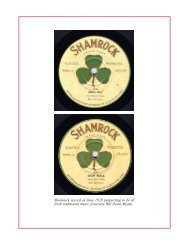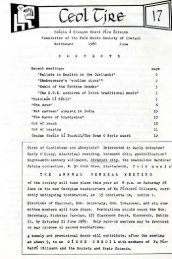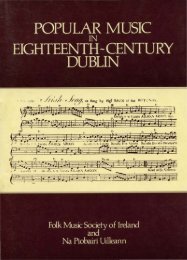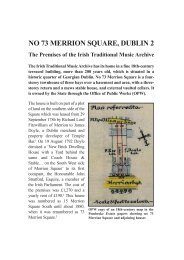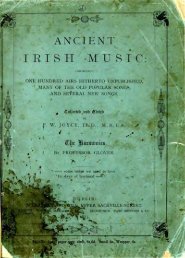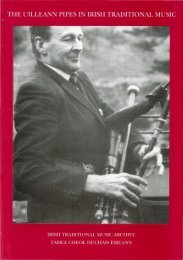Union Pipes - Irish Traditional Music Archive
Union Pipes - Irish Traditional Music Archive
Union Pipes - Irish Traditional Music Archive
You also want an ePaper? Increase the reach of your titles
YUMPU automatically turns print PDFs into web optimized ePapers that Google loves.
COURTNEY’S ‘UNION PIPES’ AND THE TERMINOLOGY OF IRISH BELLOWS-BLOWN BAGPIPES 90<br />
Píobairí Uilleann, 333 the twentieth-century term could be said to have<br />
finally triumphed after more than sixty years of existence.<br />
The <strong>Irish</strong> shift from ‘union’ to ‘uilleann’ was not however paralleled<br />
by an equivalent contemporary shift of usage in <strong>Irish</strong> America,<br />
which had not been influenced to the extent that Ireland had by<br />
either the ideology of the Gaelic League or of the emergent Free<br />
State. Although ‘uilleann pipes’ had appeared in print there as early<br />
as 1904, 334 copied from <strong>Irish</strong> newspaper sources, and was known to<br />
at least some pipers there, older habits continued and oral tradition<br />
was followed rather than print-introduced innovation. The<br />
instrument continued to be commonly known in the United States in<br />
the early twentieth century as ‘<strong>Irish</strong>’ or ‘union’ pipes. This was the<br />
practice followed by prominent piper associates of Francis O’Neill<br />
such as Bernard Delaney of Offaly and Chicago 335 Patsy Touhey of<br />
Galway and New York, 336 and Tom Ennis of Chicago. 337 However<br />
when <strong>Irish</strong> pipers began to record in some numbers on commercial<br />
78s from the 1920s, issued on the ethnic series of generalist record<br />
companies or on small <strong>Irish</strong>-American labels, ‘union pipes’ became<br />
a casualty of the commercial need for a term that would be instantly<br />
understood by record buyers. In almost every case the performers<br />
were described as playing ‘<strong>Irish</strong> (bag)pipes’ or as playing <strong>Irish</strong> reels<br />
333<br />
The name was put forward by Seamus Ennis at the first meeting, according to<br />
participants, and agreed by acclaim.<br />
334<br />
<strong>Irish</strong> World and American Industrial Liberator, New York, 23 July 1904.<br />
335<br />
See The Plain Dealer, Cleveland, Ohio, 18 June 1909, for example.<br />
336<br />
Mitchell & Small 1986: passim. Jackie Small points out (pers. comm., Apr.<br />
2012) that in his spoken introductions to his cylinder recordings Touhey refers<br />
to the instrument as ‘pipes’ and ‘<strong>Irish</strong> pipes’.<br />
337<br />
New Victor Records catalogue, July 1917. Confusingly, while this source says<br />
that ‘<strong>Union</strong> <strong>Pipes</strong>’ is the correct name for the instrument, it goes on to say that<br />
the term is ‘a corruption of the old <strong>Irish</strong> name, Uillean <strong>Pipes</strong>’. This information<br />
presumably came from Tom Ennis. His father Thomas senior spoke only of<br />
‘union pipes’ and ‘The Soft <strong>Irish</strong> <strong>Pipes</strong>’ when writing in 1902 (An Gaodhal,<br />
New York (Feb. 1902): 33



